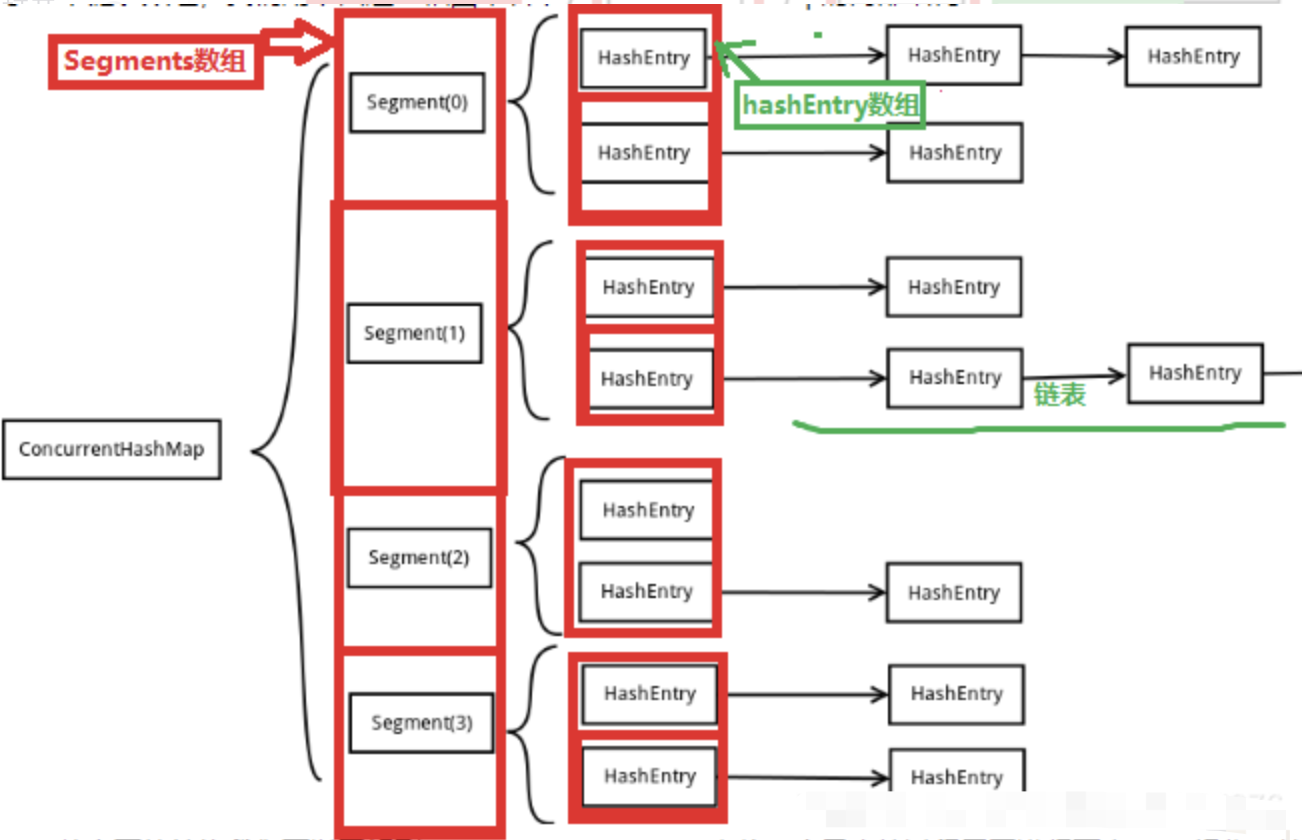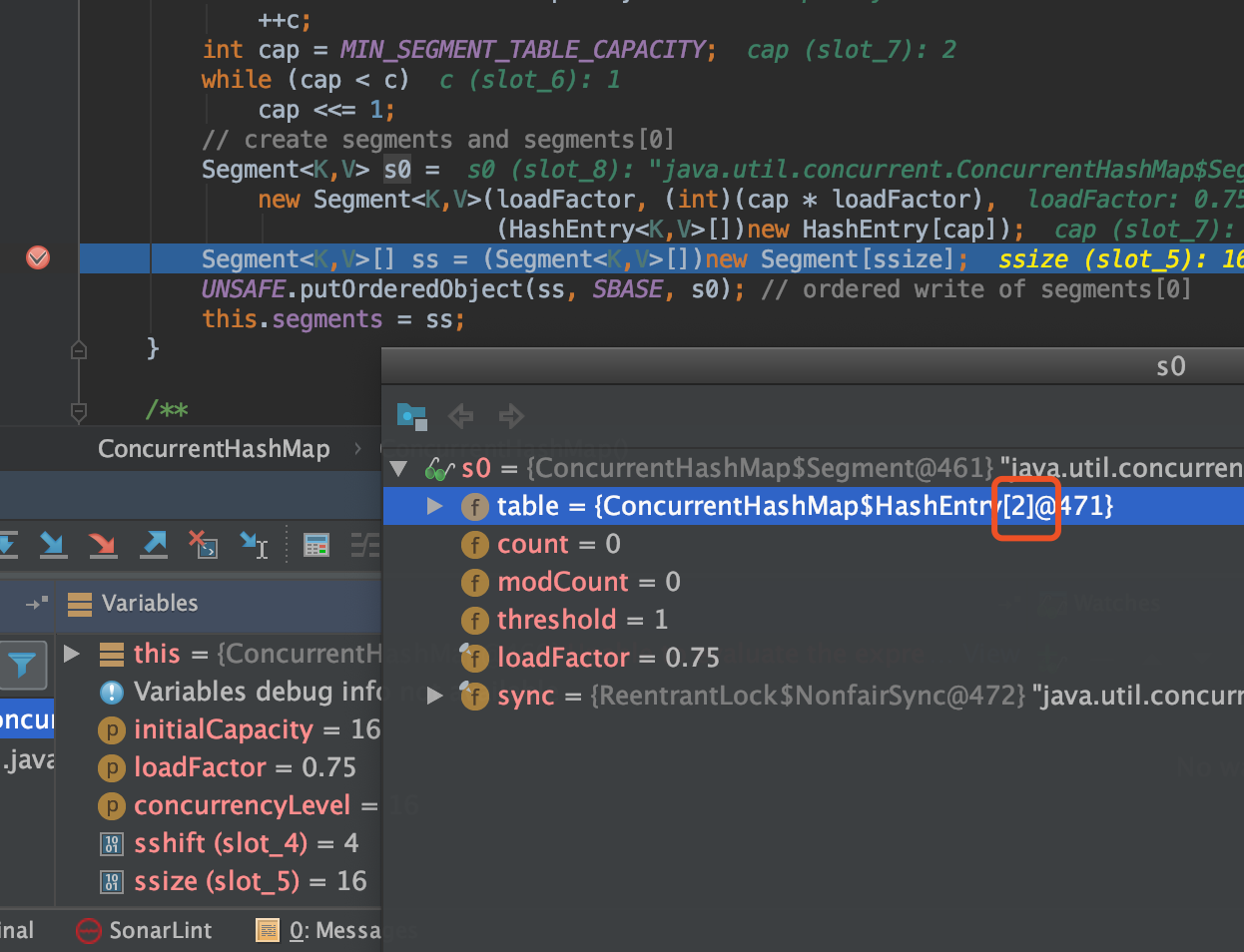TreeviewCopyright @doctording all right reserved, powered by aleen42
[TOC]
ConcurrentHashMap
底层结构:数组(Segment) + 数组(HashEntry) + 链表(HashEntry节点)

构造函数
public ConcurrentHashMap(int initialCapacity) {
// (initialCapacity, 0.75, 16)
this(initialCapacity, DEFAULT_LOAD_FACTOR, DEFAULT_CONCURRENCY_LEVEL);
}
public ConcurrentHashMap() {
// (16, 0.75, 16)
this(DEFAULT_INITIAL_CAPACITY, DEFAULT_LOAD_FACTOR, DEFAULT_CONCURRENCY_LEVEL);
}
public ConcurrentHashMap(int initialCapacity,
float loadFactor, int concurrencyLevel) {
if (!(loadFactor > 0) || initialCapacity < 0 || concurrencyLevel <= 0)
throw new IllegalArgumentException();
if (concurrencyLevel > MAX_SEGMENTS)
concurrencyLevel = MAX_SEGMENTS;
// Find power-of-two sizes best matching arguments
int sshift = 0;
int ssize = 1;
while (ssize < concurrencyLevel) {
++sshift;
ssize <<= 1;
}
this.segmentShift = 32 - sshift;
this.segmentMask = ssize - 1;
if (initialCapacity > MAXIMUM_CAPACITY)
initialCapacity = MAXIMUM_CAPACITY;
int c = initialCapacity / ssize;
if (c * ssize < initialCapacity)
++c;
int cap = MIN_SEGMENT_TABLE_CAPACITY;
while (cap < c)
cap <<= 1;
// create segments and segments[0]
Segment<K,V> s0 =
new Segment<K,V>(loadFactor, (int)(cap * loadFactor),
(HashEntry<K,V>[])new HashEntry[cap]);
Segment<K,V>[] ss = (Segment<K,V>[])new Segment[ssize];
UNSAFE.putOrderedObject(ss, SBASE, s0); // ordered write of segments[0]
this.segments = ss;
}
会生成segment[0],用作原型,后面15个位置都要new的

put方法
确定segment数组位置,并得到Segment对象,再继续处理
- segment数组下标位置
int j = (hash >>> segmentShift) & segmentMask;
segmentMask: 15(sszie - 1)
segmentShift: 28(this.segmentShift = 32 - sshift;)
sshift: 4 (2^4 = 16, 16是segment数组大小)
- 有了下标j,去得到segment[j]的Segment对象(有并发问题?)
/**
* Returns the segment for the given index, creating it and
* recording in segment table (via CAS) if not already present.
*
* @param k the index
* @return the segment
*/
@SuppressWarnings("unchecked")
private Segment<K,V> ensureSegment(int k) {
final Segment<K,V>[] ss = this.segments;
long u = (k << SSHIFT) + SBASE; // raw offset
Segment<K,V> seg;
if ((seg = (Segment<K,V>)UNSAFE.getObjectVolatile(ss, u)) == null) {
Segment<K,V> proto = ss[0]; // use segment 0 as prototype
int cap = proto.table.length;
float lf = proto.loadFactor;
int threshold = (int)(cap * lf);
HashEntry<K,V>[] tab = (HashEntry<K,V>[])new HashEntry[cap];
if ((seg = (Segment<K,V>)UNSAFE.getObjectVolatile(ss, u))
== null) { // recheck
Segment<K,V> s = new Segment<K,V>(lf, threshold, tab);
while ((seg = (Segment<K,V>)UNSAFE.getObjectVolatile(ss, u))
== null) {
if (UNSAFE.compareAndSwapObject(ss, u, null, seg = s))
break;
}
}
}
return seg;
}
- unsage操作获取或者生成Segment对象
UNSAFE.getObjectVolatile(ss, u)
仍然是通过CAS操作去把新生产的Segment对象放到j位置
if (UNSAFE.compareAndSwapObject(ss, u, null, seg = s))
break;
Segment对象进行put元素
final V put(K key, int hash, V value, boolean onlyIfAbsent) {
HashEntry<K,V> node = tryLock() ? null :
scanAndLockForPut(key, hash, value);
V oldValue;
try {
HashEntry<K,V>[] tab = table;
int index = (tab.length - 1) & hash;
HashEntry<K,V> first = entryAt(tab, index);
for (HashEntry<K,V> e = first;;) {
if (e != null) {
K k;
if ((k = e.key) == key ||
(e.hash == hash && key.equals(k))) {
oldValue = e.value;
if (!onlyIfAbsent) {
e.value = value;
++modCount;
}
break;
}
e = e.next;
}
else {
if (node != null)
node.setNext(first);
else
node = new HashEntry<K,V>(hash, key, value, first);
int c = count + 1;
if (c > threshold && tab.length < MAXIMUM_CAPACITY)
rehash(node);
else
setEntryAt(tab, index, node);
++modCount;
count = c;
oldValue = null;
break;
}
}
} finally {
unlock();
}
return oldValue;
}
确定再Segment对象中的HashEntry数组table的位置
HashEntry<K,V>[] tab = table;
int index = (tab.length - 1) & hash;
CAS获取Segment对象内部tables的index位置头部HashEntry
HashEntry<K,V> first = entryAt(tab, index);
构造新对象HashEntry,或者取旧对象HashEntry;新HashEntry对象使用头插法设置到tables[index]位置
put方法刚开始尝试加锁?
tryLock()成功,则直接进行后续操作;失败则进行scanAndLockForPut(key, hash, value);方法,仍然是尝试获取锁
/**
* Scans for a node containing given key while trying to
* acquire lock, creating and returning one if not found. Upon
* return, guarantees that lock is held. UNlike in most
* methods, calls to method equals are not screened: Since
* traversal speed doesn't matter, we might as well help warm
* up the associated code and accesses as well.
*
* @return a new node if key not found, else null
*/
private HashEntry<K,V> scanAndLockForPut(K key, int hash, V value) {
HashEntry<K,V> first = entryForHash(this, hash);
HashEntry<K,V> e = first;
HashEntry<K,V> node = null;
int retries = -1; // negative while locating node
while (!tryLock()) {
HashEntry<K,V> f; // to recheck first below
if (retries < 0) {
if (e == null) {
if (node == null) // speculatively create node
node = new HashEntry<K,V>(hash, key, value, null);
retries = 0;
}
else if (key.equals(e.key))
retries = 0;
else
e = e.next;
}
else if (++retries > MAX_SCAN_RETRIES) {
lock();
break;
}
else if ((retries & 1) == 0 &&
(f = entryForHash(this, hash)) != first) {
e = first = f; // re-traverse if entry changed
retries = -1;
}
}
return node;
}
reentrantLock.lock()(阻塞方法) vs while(!reentranLock.tryLock())(耗CPU,不断判断)
但是while里面可以做其它事情,降低CPU消耗;while执行次数可以限制,超过多少次再进行reentrantLock.lock()
while(!reentranLock.tryLock()){
// do something else
}
多线程并发put可以提前new新的HashEntry对象,后面只需要头插法设置next:node.setNext(first);
Segment对象内部tables会判断扩容
/**
* Doubles size of table and repacks entries, also adding the
* given node to new table
*/
@SuppressWarnings("unchecked")
private void rehash(HashEntry<K,V> node) {
/*
* Reclassify nodes in each list to new table. Because we
* are using power-of-two expansion, the elements from
* each bin must either stay at same index, or move with a
* power of two offset. We eliminate unnecessary node
* creation by catching cases where old nodes can be
* reused because their next fields won't change.
* Statistically, at the default threshold, only about
* one-sixth of them need cloning when a table
* doubles. The nodes they replace will be garbage
* collectable as soon as they are no longer referenced by
* any reader thread that may be in the midst of
* concurrently traversing table. Entry accesses use plain
* array indexing because they are followed by volatile
* table write.
*/
HashEntry<K,V>[] oldTable = table;
int oldCapacity = oldTable.length;
// 扩大为原来的2倍
int newCapacity = oldCapacity << 1;
threshold = (int)(newCapacity * loadFactor);
HashEntry<K,V>[] newTable =
(HashEntry<K,V>[]) new HashEntry[newCapacity];
int sizeMask = newCapacity - 1;
// 遍历老的table的每一个 HashEntry 链表
for (int i = 0; i < oldCapacity ; i++) {
HashEntry<K,V> e = oldTable[i];
if (e != null) {
// 当前位置的下一个元素
HashEntry<K,V> next = e.next;
// 当前位置
int idx = e.hash & sizeMask;
if (next == null) // Single node on list
newTable[idx] = e;
else { // Reuse consecutive sequence at same slot
// 有连续序列在新数组中一个下标位置的话,一起转移到新tables
// 类比:蜘蛛纸牌的连续序列
HashEntry<K,V> lastRun = e;
int lastIdx = idx;
for (HashEntry<K,V> last = next;
last != null;
last = last.next) {
int k = last.hash & sizeMask;
if (k != lastIdx) {
lastIdx = k;
lastRun = last;
}
}
newTable[lastIdx] = lastRun;
// Clone remaining nodes
for (HashEntry<K,V> p = e; p != lastRun; p = p.next) {
V v = p.value;
int h = p.hash;
int k = h & sizeMask;
HashEntry<K,V> n = newTable[k];
newTable[k] = new HashEntry<K,V>(h, p.key, v, n);
}
}
}
}
// 扩容完成后,在添加新元素
int nodeIndex = node.hash & sizeMask; // add the new node
node.setNext(newTable[nodeIndex]);
newTable[nodeIndex] = node;
// 最后老的table赋值给新的数组
table = newTable;
}
get(Object key)
/**
* Returns the value to which the specified key is mapped,
* or {@code null} if this map contains no mapping for the key.
*
* <p>More formally, if this map contains a mapping from a key
* {@code k} to a value {@code v} such that {@code key.equals(k)},
* then this method returns {@code v}; otherwise it returns
* {@code null}. (There can be at most one such mapping.)
*
* @throws NullPointerException if the specified key is null
*/
public V get(Object key) {
Segment<K,V> s; // manually integrate access methods to reduce overhead
HashEntry<K,V>[] tab;
int h = hash(key);
long u = (((h >>> segmentShift) & segmentMask) << SSHIFT) + SBASE;
// unsafe 获取 segment数组位置对象
if ((s = (Segment<K,V>)UNSAFE.getObjectVolatile(segments, u)) != null &&
(tab = s.table) != null) {
// unsafe 获取 Segment对象里面的HashEntry数组位置的头节点
// 遍历链表获取到直接返回
for (HashEntry<K,V> e = (HashEntry<K,V>) UNSAFE.getObjectVolatile
(tab, ((long)(((tab.length - 1) & h)) << TSHIFT) + TBASE);
e != null; e = e.next) {
K k;
if ((k = e.key) == key || (e.hash == h && key.equals(k)))
return e.value;
}
}
return null;
}